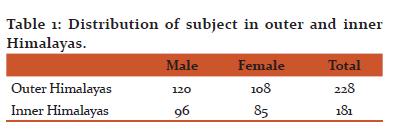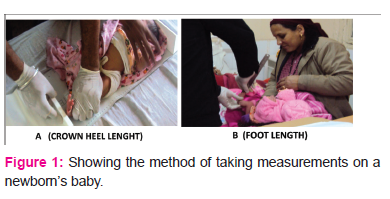IJCRR - 10(5), March, 2018
Pages: 52-55
Date of Publication: 15-Mar-2018
Print Article
Download XML Download PDF
Estimation of Height of a Neonate in Relation to Foot Length in Different Zones of Himachal Pradesh
Author: Soni Pankaj, Kapoor Kanchan
Category: Life Sciences
Abstract:Introduction: Stature is one of the most important and useful anthropometric parameter that determine physical identity of an individual and hold a special place in the field of Forensic anthropometry. Estimation of stature is significant in the personal identification in case of murders, natural disasters and accidents. Besides determination of race, sex and age of the unknown individual, estimation of stature enhances the reliability of identification.
Methods: The present study is based on the measurements of crown heel length and foot length of total 409 full term normal newborns (216 male, 193 female) delivered in labor ward of civil hospitals in Himachal Pradesh, measurements of the parameters were taken in 12-24 hours after birth, measured by using digital vernier caliper.
Results: The mean, standard deviation and correlation was calculated between foot length and height of newborn. High significant value was found in foot length (p=0.001) for both male and female. Middle Himalayas shows high correlation between male and female (r=0.44)
Conclusion: Crown heel length and foot length were significantly correlated with each other in all the three zones of Himachal Pradesh and high correlation was found in females
Keywords: Himachal, Anthropometry, Newborn, Crown heel length, Foot length, Himalayas
DOI: 10.7324/IJCRR.2018.1059
Full Text:
INTRODUCTION
India is a secular country where people of different ethnic groups, religions, education and sociological status live together. So one cannot expect the same type of growth pattern in all the places and the normal standard of anthropometric measurements varies from places to places.
Newborn anthropometry is the most important as there is no such measurement for universal use because it is dependent on racial, ethnic, environmental, age factors, biological, ecological and geographic factors1.
Measurement of human individuals for the purpose of understanding human physical variation has been a long time practice. Today this practice is called anthropometry. Anthropometry is series of systematized measuring techniques that expresses quantitatively the dimensions of the human body and skeleton. Anthropometry is the single most portable, universally applicable, inexpensive and noninvasive method available to assess the proportion size and composition of the human body. It provides a simple and objective method of assessment of fetal growth at the time of birth2.
Growth the vital process is measured by measuring the height of a person, which is a sum of the length of certain relationship with form of proportions to the total stature. This relationship is very useful anthropologically to find racial differences and medico-legally, when only parts of the deceased body are available. Height estimation by measurement of various long bones has been attempted by several workers with variable degree of success. Each worker has derived his own formula for calculating the stature from long bones. However, foot measurement has not frequently been used for this. It was Rutishauser (1968) who for the first time showed that reliability of prediction of height from foot length was as high as that from long bones3.
The geographical location, racial and environmental factors are responsible for the differences in growth and body composition in individuals. In view of this, we selected to undertake an anthropometric study of normal newborns in hills of Himachal Pradesh, which is known for its unique and uncanny socio-political and cultural tradition. Its unique composition, location, and character all makes it the bounder land4.
The aim of the present study is to measure crown heel length and foot length of full term newborns from different zones of Himachal Pradesh and to calculate mean value, standard deviation and correlation coefficient of each zone and compare the present findings with the available literature on the same.
AIM AND OBJECTIVE
To calculate and compare mean value and standard deviation of anthropometric measurements of all three zones of Himachal Pradesh. Determine the correlation between crown heel length and foot length and compare the present findings with the available literature.

MATERIALS AND METHODS
The study was undertaken on 409 normal full term newborns comprising of 216 males (52.81%) and 193 females (47.19%) delivered in the labor ward of civil hospitals of Himachal Pradesh. All the parameters were measured in 12-24 hours after birth by using infantometer and stiff transparent metric ruler (cm scale).
Ethical clearance was taken from Geetanjali University, Udaipur, Rajasthan, (India). Informed consent of mother /father /guardians and permission from Director of Health Services, Shimla, Himachal Pradesh government was taken before the study.
The exclusion criteria included neonates of high risk or complicated pregnancies having medical illness such as hypertension, diabetes mellitus, infection, autoimmune disease, heart disease etc. Neonate who had caput succedaneum and cephalheamatoma and who were delivered by caesarean section showing any craniofacial deformity were also not included in the study.
The crown heel length was measured in supine position with full extension of knee and distance between top of head and heel when press against a vertical surface and role on a stabilizing board. Foot length was measured from the heel to tip of the toe. Heel was fixed against the vertical end of the gauge and the sliding end was adjusted against the tip of the big toe after straightening the foot and the foot length was recorded.(Fig1).

The data for each newborn was recorded in a form and analyzed. For comparison of the means of the anthropometric measurements unpaired t- test was used.
OBSERVATION AND RESULTS
The present study was conducted to obtain a baseline standard criterion (Mean ±SD) of normal full term newborn’s parameters and their correlation with each other. Foot length (p=0.001) in Himachal Pradesh showed statistically significant sex difference (p<0.05). Table 2 shows the mean and standard deviation of full term newborns in overall Himachal, outer Himalayas and inner Himalayas.
Crown heel length and foot length were significantly correlated to each other. In all the zones high correlation was found in females i.e outer Himalayas (r= 0.470), inner Himalayas (r=0.461) and in overall Himachal Pradesh (r=0.442). Inner Himalayas shows high correlation between male and female (r= 0.449) and outer Himalayas having minimum value (r= 0.254). (Table-2)
The mean and SD for crown heel length and foot length described in table-2. The mean value for male is higher than females.

DISCUSSION
It is universally acknowledge the size at birth is an important indicator of fetal and neonatal health in the context of the both individuals and populations. Size at birth reflects two factors: duration of gestation and rate of fetal growth. It must therefore be considered with respect to gestational age; the increase in size that occurs with age will lead to severe confounding of growth and maturity5.
India is a land of diversity and people of different province have different food habits, life style, socio-cultural trend and ethnicity. The diversity is evident in their physical structure and anthropometric parameters. It is essential to study the physical features and environment in which a particular community is living.
The existing newborn anthropometric data against which deviations from normal could be assessed are generally lacking in developing countries. In this study, measurements of newborns’ anthropometric parameters are compared with the standards of other countries. But these standards have some limitations related to differences in genetic, nutritional and environmental factors.
The estimation of height from various long bones, hand length, head length, length of clavicle has been attempted by many workers. However, foot dimensions have not frequently been used for this. The present study deals with the observations on correlation of crown heel length with foot length in newborns of Himachal Pradesh. et. al.
Patel and shah in 2007 conducted a study in age group 17 to 22 years in Gujarat region. A good correlation of height was observed with foot length and it was statistically significant3. Chandra et. al.. conducted a study in Agra between ages 18-28 years and estimate the stature from thumb length. A significant correlation was observed between thumb length and stature6. Seema and Mahajan estimate the stature from the cranial length in Punjabi people and linear regression analysis was done and found to be statistically significant and positive in both males and females7. Rani et. al. 2011 correlate stature of individual with maximum length of clavicle in Delhi 2011 and found that maximum length was best parameter for stature estimation from clavicle8. Singh et. al. 2013 estimate stature by measurements of foot length and foot breadth. Foot length was more useful parameters than breadth for stature estimation9.
Qamra et. al. 1979 derived a regression equation between foot length and height in north west india population. Correlation coefficient between foot length and height was +0.69 in male and +0.70 in females3.
No such type of study was carried out in Himachal Pradesh on newborn.
CONCLUSION
The present study arrived at comprehensive comparative findings in both the regions i.e outer and inner Himalayas of Himachal Pradesh in terms of Crown heel length and foot length. Crown heel length showed high correlation with foot length and the maximum correlation was found in female newborns (r=0.44) in Himachal Pradesh.
ACKNOWLEDGEMENT
The author acknowledge and thanks the guidance provided by Professor Dr. Suresh Soni, Postgraduate degree College, Bilaspur, H.P. and sincere thanks to Directorate of Health Services, Shimla, Himachal Pradesh for their support.
Source of funding: None
Conflict of interest: None
References:
- Shastry CKR and Bhat BPR. Anthropometric measurements of newborns. Int J Contemp Pediatr. 2015; 2(2): 85-89.
- Franciscus RG and Long JC. Variation in Human nasal height and breadth. Am J Phys Anthropol. 1991 Aug; 85(4): 419-27.
- Patel SM, Shah GV and Patel SV. Estimation of height from measurements of foot length in Gujarat region. J Anat Soc India. 2007; 56(1): 25-27.
- Balokhara JM. The Wonderland Himachal Pradesh. 1st Ed. India. H.G publication. 2011.
- Kramer JK, Farnworth ER, Johnston KM, Wolynetz MS, Modler HW and Sauer FD. Myocardial changes in newborn piglets fed sow milk or milk replacer diets containing different levels of erucic acid.Lipids.1990 Nov;25(11): 729-37.
- Chandra et. al.. A study of correlation between stature and thumb length. J. Anat. Science. June 2016; 24(1): 47-51.
- Seema and Mahajan A. Estimation of personal height from the length of head in Punjab. IJPAES. Sept-Nov 2011; 1(3): 205-208.
- Rani Y, Naik SK, Singh AK and Murari A. Correlation of stature of adult with the length of clavicle. J Indian Acad Forensic Med. July 2011; 33(3): 194-96.
Singh JP, Rani Y, Meena MC, Murari A and Sharma GK. Stature estimation from the dimensions of foot in males. Insanbil Derg 2013; 2(1): 15-20.
|






 This work is licensed under a Creative Commons Attribution-NonCommercial 4.0 International License
This work is licensed under a Creative Commons Attribution-NonCommercial 4.0 International License